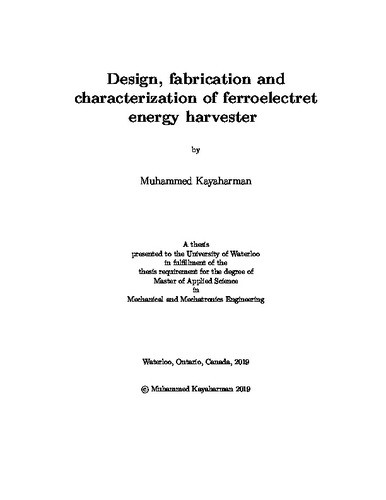UWSpace will be migrating to a new version of its software from July 29th to August 1st. UWSpace will be offline for all UW community members during this time.
Design, fabrication and characterization of ferroelectret energy harvester
| dc.contributor.author | Kayaharman, Muhammed | |
| dc.date.accessioned | 2019-04-22 18:56:05 (GMT) | |
| dc.date.available | 2019-04-22 18:56:05 (GMT) | |
| dc.date.issued | 2019-04-22 | |
| dc.date.submitted | 2019-04-16 | |
| dc.identifier.uri | http://hdl.handle.net/10012/14545 | |
| dc.description.abstract | Energy harvesters gained significant interest over the last decade with the reduce in power requirements of today’s electrical devices and with the fast developments in low-power electronics. Limited battery life is one of the weak spots that constrains the potential of possible applications. There are only two options for remote applications when the battery is died. Either charging the battery or replacing the battery with a new one. And both of these solutions are time-consuming and expensive. On the other hand, for some of the remote applications, such as health monitoring for aircrafts, battery replacement or charging may not even be an option because of dangerous or inaccessible area conditions. In this research, a one-layer ferroelectret energy harvester is designed and fabricated. Ferroelectret energy harvester is modeled as a mass-spring-damper under harmonic base excitation. d33 piezoelectric constant of the harvester is measured with laser interferometry method. Natural frequency of the harvester is measured experimentally with a frequency sweep up to 1 kHz. Optimum resistance of the three energy harvesters measured with impedance matching to maximize the transduction from mechanical domain into electrical domain. The effect of constant stress and stress-cycling on the stability of ferroelectret energy harvester is analyzed. According to our experiment results, constant stress significantly increased the d33 piezoelectric charge constant and the natural frequency (wn) of the harvester. Increased d33 constant also increased the the power output of the harvester under constant stress compared to stress-cycling and stress-free. Also output voltage and the capacitance value of the energy harvesters are affected by constant-stress and stresscycling. And last, mathematical model is compared with experimental results to validate the piezoelectricity of ferroelectret energy harvesters. | en |
| dc.language.iso | en | en |
| dc.publisher | University of Waterloo | en |
| dc.subject | energy harvesting | en |
| dc.subject | piezoelectric | en |
| dc.subject | ferroelectret | en |
| dc.subject | vibration | en |
| dc.title | Design, fabrication and characterization of ferroelectret energy harvester | en |
| dc.type | Master Thesis | en |
| dc.pending | false | |
| uws-etd.degree.department | Mechanical and Mechatronics Engineering | en |
| uws-etd.degree.discipline | Mechanical Engineering | en |
| uws-etd.degree.grantor | University of Waterloo | en |
| uws-etd.degree | Master of Applied Science | en |
| uws.contributor.advisor | Yavuz, Mustafa | |
| uws.contributor.advisor | Abdel-Rahman, Eihab | |
| uws.contributor.affiliation1 | Faculty of Engineering | en |
| uws.published.city | Waterloo | en |
| uws.published.country | Canada | en |
| uws.published.province | Ontario | en |
| uws.typeOfResource | Text | en |
| uws.peerReviewStatus | Unreviewed | en |
| uws.scholarLevel | Graduate | en |

